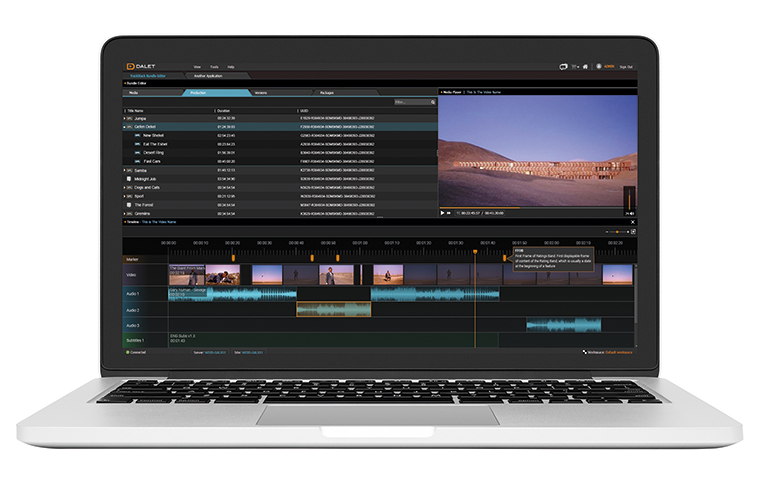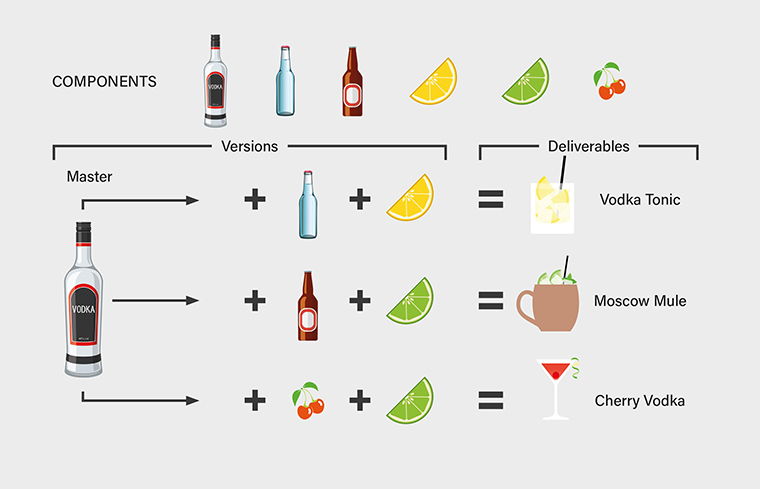Your component-based future

Posted on Aug 2, 2019 by FEED Staff
Sponsored editorial
You may not be working with component-based workflows yet, but if you want to keep pace with a rapidly changing media industry, you will
A component-based workflow explodes the old idea of distribution in which each individual version of a finished piece of content (different formats, edits according to territories, language dubs) is produced as a single flattened file – and sent and stored as such. IMF is the first way of implementing component-based workflows for the moving image industry and is growing in importance – particularly with it being the mandated delivery format for Netflix – but the concept extends across many industries needing to access digital assets to create multiple versions of a final product.
In the component-based world, versions are created by sets of instructions pointing to the individual files – or components – of the project (image, audio, subtitling, etc). Rather than baking every project into one big pie every time, component-based workflows allow each plate to be filled with a tapas approach – “I’ll have one of that, one of those and a little bit of this”. It’s flexible and light and obviates the need for endless versions of every project piling up in storage.
Given the expanding number of versions of video content now required for multiple delivery platforms, regions and devices, going component-based makes sense for a company wanting to safeguard its business future. Adopting a component-based workflow tends to make a workflow much more efficient with a much more granular viewpoint. Instead of continuously moving around a big number of large files, companies only need to move around small files, which are the component parts of a programme. This is bound to decrease costs, increase flexibility and simplify integration with partners and the adjoining parts of content life cycle.
Luc Comeau, director of Market Strategy & Portfolio – MAM at Dalet, explains how working directly with components can make life a lot easier for content creators: “If I need to fulfil new subtitles for a project using a component-based approach I don’t have to work with a monolithic flattened video file any more, where I would need to go back to the source and re-render and re-conform. As I get subtitle updates from my localisation partner, I can then inject them into that component-based structure and easily generate the new deliverable.”
And, of course, storage of all the multiple versions of content quickly becomes absurd. “If I want to keep 150 localisations available, then with an hour programme, I have 150 hours of content I have to manage, as opposed to an hour plus whatever the minutes are for the differentials of the versions I’m releasing,” explains Comeau.
“Automation can ensure optimal handling of titles, both at the point of creation and also over time as versions are created, managed and maintained”

The right tools
To best leverage component workflows, companies need tools to clearly track and monitor all of the programme components, and a good media asset management (MAM) system is essential in this. Additionally, a good MAM will need to understand and support the concept of versioning and know what individual core data elements are, as well as what the bundles formed from these components are, where those elements are and which are relevant for each individual job.
Automation is another important factor in a successful component-based workflow set-up. While this new type of media supply chain is more efficient, it is also more complex. A good orchestration engine is required which can act at the level of the individual components, as well as at the level of the final complex versions assembled out of those individual files.
The orchestration engine must also then be able to supply the correct media supply-chain rules to the content, whether it might be a transcode, the QC of an individual component, the delivery of a proxy version of the video to a post house for dubbing or sending an original version from a studio to a broadcaster, and this needs to be able to easily happen at the level of the individual objects and an assembled version.
Ultimately, it is humans who make the content, even if parts of the workflow are automated, and so a user interface that allows people along the supply chain to assess the content and make effective decisions about it is also vital. Users need to be able to see and understand the relationship between all the programme components for each version or bundle for delivery. The UI needs to include an information-rich timeline so that it’s clear to see on the fly what has resulted from the combining of the various components.
“Along with a data model that allows me to create all these component relationships, I have a visualiser that allows me to see the source elements, used in the creation of those compositions,” says Comeau. “Through our Dalet bundle, you have a UI that looks very similar to a video editor, where you can see the assembly of both the original master content, the replacement video in the timeline where we might be putting in localisation, and metadata for the output. It allows you to do a quick QC before you finally render.”
Many companies are stuck in old workflows and it may seem scary to have to make the future-proofing jump to component, but delay may prove more painful than taking the plunge. “With Dalet inventory and orchestration tools, we focus on users being able to visually compose and visualise all the different derivative outputs, and manage and choreograph those at an atomic level.”
For more information, on Dalet Versioning & IMF solution, visit bit.ly/DaletIMF. For the white paper on Dalet IMF, visit bit.ly/DaletIMFWhitePaper.
This article originally featured in the July 2019 issue of FEED magazine.









